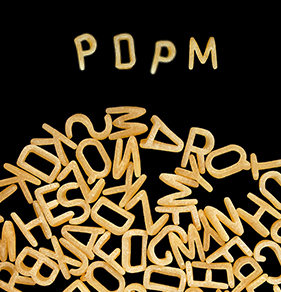CMS Adds Six New Quality Measures to SNF Evaluation for 5-Star Ratings
You may have heard that the CMS has been planning to adjust the Quality Measures used to calculate 5-Star Quality Ratings and that some of these will be used later to affect reimbursement. As a healthcare provider, it will be important for you to get to know these new measures, so that you may help your organization track them, and if necessary, implement plans to improve performance in one or more of these areas.
The overall 5-Star rating has grown in importance since its inception in 2008. More and more hospitals, payers and providers are utilizing 5-Star information to determine whom to include in referral networks. Additionally, patients and their families are becoming ever more savvy regarding 5-Star ratings and are using them to help them make decisions about their post-acute choices.
The 5-Star Quality Measures (QMs) have been a key component of the overall 5-Star calculation. In recent years, there has been controversy over whether the overall improvement of QMs across the nation was reflective of improved care versus SNFs learning how to report their data in the best light. In an effort to improve the accuracy of the QMs and to reflect clinical measures that have real-life impact, as well as to increase scrutiny of quality of care of short-stay patients, CMS has added new Quality Measures this year. Five of these QMs will be phased into calculation of the 5-Star ratings between July 2016 and Jan 2017. The anxiolytic/hypnotic measure will not.
There are now six new Quality Measures. Four pertain to short-stay residents, and two apply to long-stay residents. Data used to calculate some of these measures now include claims data, instead of relying purely on self-reported data such as information from the Minimum Data Set (MDS). All of these new measures, except for the anxiolytic/hypnotic measure are risk-adjusted.
Short-Stay Measures*
Discharged to community
Patients who have had an ED visit
30-day rehospitalizations
Who had improvement in function by time of discharge
Long-stay Measures*
Patients whose independence has worsened
Receiving anxiolytics or hypnotic medications
*A short-stay patient is one who has stayed at a SNF for 100 days or less, a “long-stay” patient is one whose stay exceeds 100 days.
Short-Stay Measures
Percentage of patients discharged to the community
Right now about 54% of patients who are admitted nationally improve well enough to be discharged home or to a non-institutional setting. This will be based on claims, so patients who are not part of a Medicare Fee-for-Service program (FFS) will not be included. Discharging a patient to home is obviously considered desirable.
A patient is considered to have had a “successful” discharge to community if the patient is discharged within 100 days of the nursing home admission and in the subsequent 30 days does not pass away, is not rehospitalized and is not admitted to another SNF.
Percentage of patients who have had an Emergency Department visit
Understandably, CMS considers Emergency Department (ED) visits inefficient and a suboptimal way to provide care to SNF patients. Not only is the transport and care expensive, but the emergency physician is not likely to be familiar with the patient. Naturally, ED visits increase risk of hospital admissions. If a patient is admitted through the ED, the rehospitalization QM will be affected, but not the ED QM for that occurrence.
Percentage of patients who were rehospitalized after a nursing home admission
This is also claims-based. This includes both regular and ‘observation’ admissions. This measure is going to be risk-adjusted, based upon a relatively complex system of calculation. Factors which would affect the rehospitalization scoring include several resident factors called “covariates.” Covariates include demographic, clinical and functional factors and are drawn from both Medicare Claims and from MDS data. Further adjustment of this QM is based upon a calculated “expected rate” of rehospitalizations based on the previous 12 month covariate information from the SNF in question.
Notable resident classes excluded from this calculation include patients receiving the hospice benefit, and patients who are not in Medicare FFS plans, such as Medicare Advantage patients. Also, patients who do not have both Medicare A and B will be excluded.
Percentage of patients who made improvements in function
Based on the MDS, patients will be determined to have either improved or not. A higher percentage of patients who have improved in their level of functioning is better.
New Long-Stay Measures
Percentage of patients whose ability to move independently has worsened
This is based on MDS data.
Percentage of residents who received an anti-anxiety or hypnotic medication
This is based on MDS data. CMS aims to decrease the burden of psychoactive medications on patients. The original CMS proposal included antidepressant medications, but after receiving feedback from providers, the decision was made to exclude antidepressants. Because anxiolytic and hypnotic medications have significant potential for harm for elderly patients, with questionable long-term benefit, it is understandable that these are included in the new Quality Measures.
What you can do about it
Now that you have had a brief overview of the QMs you’ll want to learn more about what goes into their calculation and pay attention to these measures. Check out some of the resources below in order to learn more.
Of course, the previous measures are still in place. It is still of vital importance to track the original QMs, as antipsychotics, wounds, falls, infections and other measures continue to affect the health, safety and quality of life of your patients.
Being a healthcare provider continues to be an ever-increasing challenge. Keeping up with clinical and regulatory developments is hard, but remaining engaged and informed is key in helping you navigate the waters ahead.
More Information & References
CMS release of new Quality Measures:
Final technical specifications of the new Quality Measures:
CMS link for quality resources:
https://www.cms.gov/Medicare/Provider-Enrollment-and-Certification/QAPI/qapiresources.html








